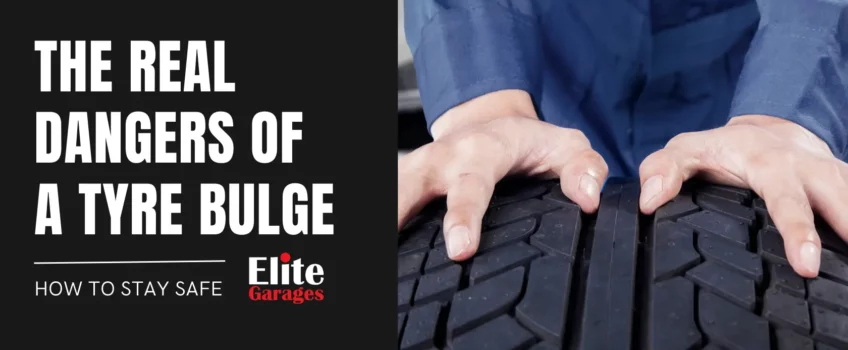
Got A Tyre Bulge? What To Do Next
Tyres are one of the most critical safety components of your car and play a crucial role in the overall safety and performance of any vehicle. They are the only point of contact between the car and the road, providing the grip and support it needs to move efficiently on various surfaces. However, they can develop issues like a tyre bulge in the sidewall, also known as a tyre bubble. This article provides useful information on what a tyre bulge is, how it is formed and what you need to do.
What is a Tyre Bulge?
A tyre bulge is a visible swelling or bump on the sidewall of a tyre. It is caused by air pressure that builds up inside the tyre and pushes the rubber outwards. This can weaken the tyre’s structure, making it vulnerable to a blowout or sudden loss of control while driving.
How is a Tyre Bulge Formed?
A tyre bulge is formed when the sidewall of a tyre develops a visible swelling or a bump. It is usually caused by air pressure building up inside the tyre, which pushes the rubber outwards, causing the tyre to bulge. A tyre bubble is a serious safety issue that you should never ignore. It is caused by factors such as overinflation, impact damage, and underinflation. Here’s a simple breakdown of the causes of a tyre bulge:
- Overinflation can cause excessive air pressure inside the tyre, leading to the sidewall bulging out.
- Impact damage can be caused by hitting a pothole or other road hazard, which can cause damage to the sidewall and lead to a bulge.
- Underinflation can cause the tyre to flex more than it should, leading to excessive heat generation and a tyre bulge in the sidewall.

What is a Tyre Sidewall?
The sidewall is the area of the tyre that runs from the bead of the tyre (where the tyre meets the wheel rim) to the tread (the part of the tyre that comes into contact with the road). The sidewall of the tyre is responsible for maintaining the tyre’s structural integrity, and any damage to it can lead to a bulge.
Bulged Tyres And MOT Tests
The MOT test checks the overall safety of your car, including the tyres. The MOT considers a tyre bulge as a serious safety issue which means if your car has a bulge in the sidewall of a tyre, it will fail the MOT test. As such, it is essential to get it fixed or ideally replaced before booking your MOT.
Remember, a tyre bulge CANNOT be repaired! It’s a sign of internal damage and you need to replace the affected tyre immediately. If you continue to drive with a bulge in the sidewall of your tyre, it can lead to a blowout or a sudden loss of control while driving. In most cases, it’s best to replace the tyre if you discover a tyre bulge as it may not be safe to drive on.
If your tyres are relatively new and have been looked after, you could consider repairing a tyre bulge but only if the tyre has minimal damage and there are no visible cracks or cuts in the sidewall.
Tyre Safety Tips
Tyre safety is crucial for the overall safety of the driver and passengers. A well-maintained tyre can improve the handling, fuel efficiency, and braking distance of a vehicle which help to reduce the risk of accidents while enhancing driving comfort.
At the same time, a worn-out or damaged tyre can greatly reduce traction and grip which could easily result in potentially fatal accidents. To ensure that your tyres are in good condition, here are some tyre safety tips to keep in mind:
- Check the tread depth of your tyres regularly. The minimum legal tread depth is 1.6mm in the UK. However, it is recommended to replace your tyres when the tread depth reaches 3mm.
- Check for any signs of damage or punctures in your tyres regularly. If you notice any issues, be sure to book a tyre safety check at your nearest Elite Garages branch.
- Make sure that your tyres are inflated to the correct pressure as overinflated or underinflated tyres can impact the handling of your car while leading to premature tyre wear. It could also result in internal damage which can develop into tyre bulge.
6 Causes Of Tyre Wear
Tyres are one of the most important components of a vehicle and their wear can greatly impact safety and performance. There are several factors that can contribute to tyre wear, including the following:
- Driving style – Aggressive cornering and braking can greatly increase tyre wear. Be sure to practice smooth and controlled driving to help reduce this.
- Tyre Position – The tyres on the driven wheels wear more quickly. Front-wheel drive cars, which also handle steering, will experience more wear on the front tyres.
- Speed – Driving at high speeds generates more heat, leading to increased wear so make sure you stick to the speed limit for your safety and that of other road users.
- Excess Load – Adding more weight to the car, like luggage and sporting gear, for example puts more pressure on the tyres, leading to increased wear. Heavier vehicles will also wear out their tyres faster.
- Tyre Pressure – Ensuring your tyres are at the right pressure is critical for tyre wear. Underinflation and overinflation can cause premature wear.
- Wheel Alignment – Tyres can wear unevenly if the wheel alignment is out or if suspension components, like shock absorbers, are worn. Regular checks and maintenance can help to ensure proper wheel alignment and potentially spot a tyre bulge in the process.
Also Read: Why Part-Worn Tyres Could Cost You More
Tips to Extend the Lifespan of Your Car Tyres
Car tyres are expensive, and therefore, it is essential to extend their lifespan to get the most out of them. Here are some tips to help you do just that:
- Rotate your tyres regularly to ensure that they wear evenly and last longer.
- Avoid harsh braking and acceleration as this can lead to premature tyre wear and tear.
- Keep your tyres clean and free from debris as this can also help prevent tyre damage.
Remember, when it comes to tyres, safety must always come first! If you have a tyre bulge in the sidewall, it’s best to replace the tyre than risk driving on a damaged one. Make sure you check your tyres regularly and don’t hesitate to seek professional help if needed. Your local garage should be able to inspect the tyre and advise you if it can be repaired safely. They’ll also provide a quote for repair or replacement.
Tyre Repairs And Replacements At Elite Garages
As you’d expect from a renowned family-owned and managed company, Elite Garages offer greater value with no hidden costs or small print. Our website also makes it very easy to reserve your tyres online. We have a wide selection of budget, mid-range and premium tyres to choose from. And, if we don’t happen to have the exact tyre you want in stock at any given moment — our warehouse ships out daily deliveries so you can get your tyres fitted the next day.
Considering the serious nature of a tyre bulge in the sidewall, we cannot stress enough how important it is to get it seen to as soon as possible. If you have any concerns about your tyres, including a tyre bulge, please visit your nearest Elite Garages, including Maidstone, Shaftesbury, Portsmouth, Pulborough and Brighton among many others across the south and south east of England.
What’s more, you can also join the Elite Members Club to receive FREE MOT Reminders along with other special offers and expert motoring advice.
FAQS
Click the + to read any answer or visit our most FAQ page to review the most frequently asked questions across all our Elite Locations.
If you click on a ‘Category’ or ‘Tag’ link, the page will ‘refresh’ and reload the page showing the top of the page first, you’ll then just need to scroll down to the FAQ section to see the results for the Category or Tag you selected.
Yes, a tyre bulge in the sidewall will result in an MOT failure as the test checks the overall safety of your car, and considers a tyre bulge a serious safety concern.
No, it is not safe to drive on a tyre with a bulge in the sidewall as it indicates internal damage, and the tyre needs to be replaced immediately. Driving on a tyre with a bulge can lead to a blowout or sudden loss of control while driving.
A tyre bulge is formed when the sidewall of a tyre develops a visible swelling or bump. It is usually caused by air pressure building up inside the tyre, which pushes the rubber outwards, causing the tyre to bulge. There are several factors that can cause a tyre bulge, including overinflation, impact damage, and underinflation.
About Us
Opening Times
Saturday : 8:30–4:00
Sunday : closed
More Information
Contact UsCustomer Information Pack
Check MOT Due Date
Free MOT reminder
Careers


